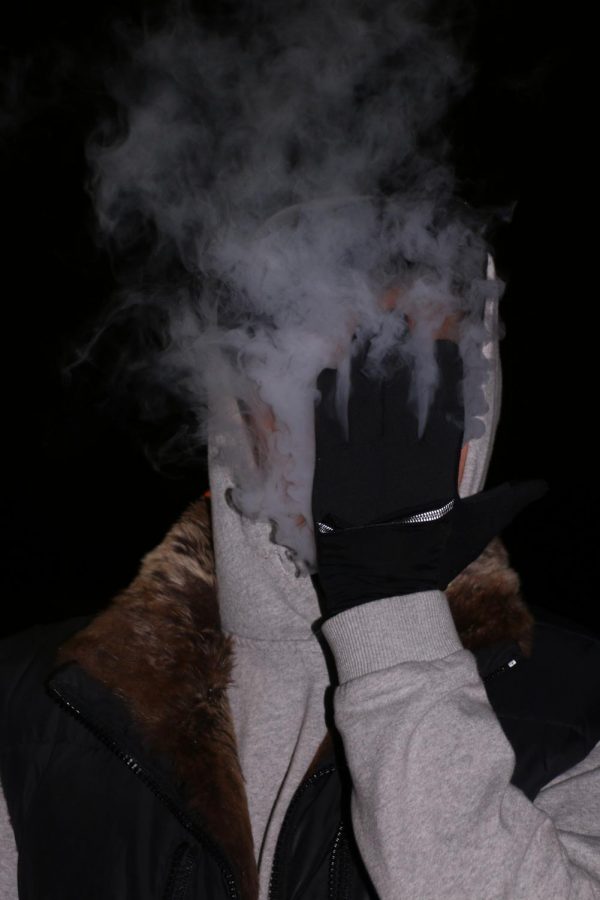Vape Epidemic
As the usage of cigarettes declines, a growing number of teenagers have begun using e-cigarettes, now a problem in schools.
It was the summer of 2016. Instead of spending her evening at the pool enjoying the fleeting warm weather, junior Alice Lee, whose name has been changed along with the rest of the student names in this story, was huddled in her friend’s basement with a few others. The air was thick and hazy; the mustiness of the basement mixed with the anxiety of experimenting with an new addictive substance.
“Do you want to try it?” Her friend asked, motioning to the source.
Lee nodded and nervously took the small device. She inhaled while vapor rose to her cheeks, then immediately exhaled.
“I felt kind of rebellious because I know you’re not supposed to do it,” Lee said.
Lee’s story isn’t uncommon. According to the Centers for Disease Control and Prevention, 38 percent of high school students have tried e-cigarettes, commonly known as vapes.
The increase in the number of students who vape in school has started to spark more awareness in staff and administration.
“The beginning of this year was really [when] we saw a big uptick [with vaping] and then maybe a little at the end of last year,” assistant principal Brian Zawislak said. “We are aware that there is a situation in school, and a couple times a week we are talking to students about these risks that affect both their bodies and smart decision making.”
Many staff members are shocked by the similarities vapes have to school supplies and are now making sure to watch out for students who vape in class.
“I can not believe the resemblance vapes have with pens, highlighters, USB’s, etc.,” math teacher Katie Vitale said. “I have not caught any students vaping in my class. In my opinion, this affects their well being, and I want to make sure they are held accountable and aware of the seriousness of their actions.”
VUSE and blu are major e-cigarette brands owned by big tobacco companies. They are both commonly bought by high school students. Many compare the new trend of vaping to the use of cigarettes when they were popular.
“When cigarettes were really common, people used to think that there was nothing wrong with them,” junior Katherine Stewartsaid. “Then later on, people who were smoking ended up having multiple health problems.”
Despite recognizing the potential health hazards that may come along with vaping, Stewart—who vapes regularly—continues to vape.
“I’m living in the moment, and I’m not really worried about [the health problems] right now,” Stewart said. “I’ll handle it when it comes.”
There are multiple reasons why teenagers begin using e-cigarettes, according to many teen users.
“I think [it started in part because] someone just thought it was cool, and then it’s just like a cycle,” sophomore William Jackson said. “People think it’s funny and cool when doing it, but then you get addicted to it.”
Jackson, who also vapes regularly, was caught vaping on school grounds this year.
“I found it on the ground and a bunch of my classmates do it, so they said ‘do it,’ and I did,” Jackson said. “My teacher saw me blow the cloud and said, ‘Are you serious? Give it to me.’”
Many of those who vape say they see other students doing so daily and that it is very common for them to do it at or around school. However, vaping or smoking on school grounds is a level two violation and could possibly result in a suspension up to five days for a first-time offense.
The media center has become one of the areas at school where students vape, and media center specialist Toni Isaac says it has become a distraction for other students.
“Students should be able to come to the media center and be assured that they are not being exposed to airborne carcinogens,” Isaac said. “The students who are vaping usually make it difficult for the students that are here to study or do homework to focus.”
According to Isaac, the media center staff finds vape paraphernalia like chargers or vaporizers about twice a month and wants to emphasize that they are harmful.
“Vape companies are intentionally targeting young people with flavors like Dr. Pepper, Jolly Rancher, etc.,” Isaac said. “What they do not tell you is that most oils contain at least a small amount of nicotine.”
Your donation will support the student journalists of Troy High School - MI. Your contribution will allow us to print our work, purchase equipment and cover our annual website hosting costs.

